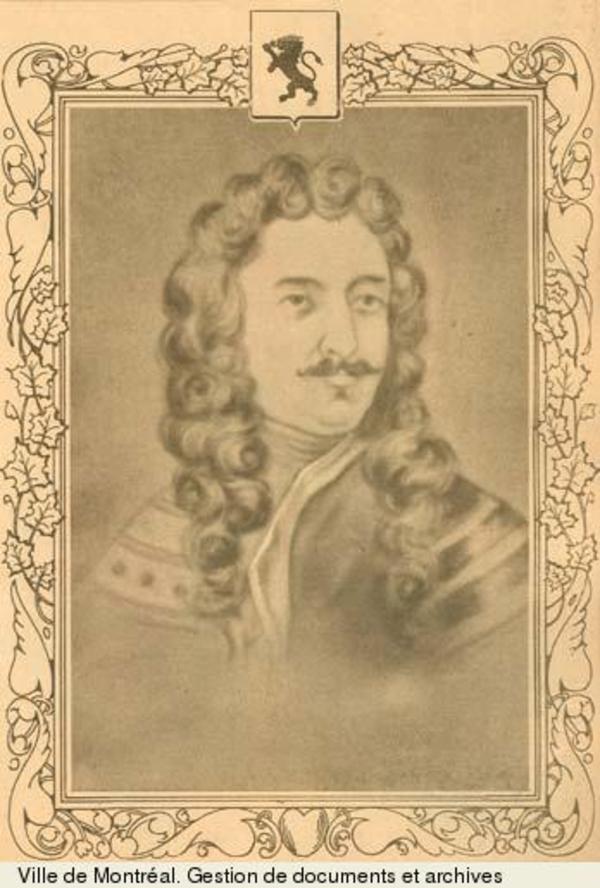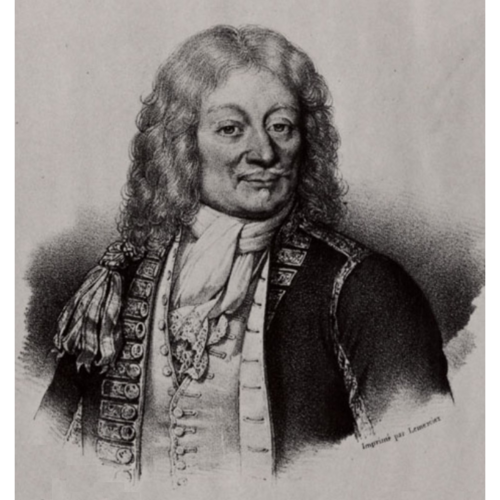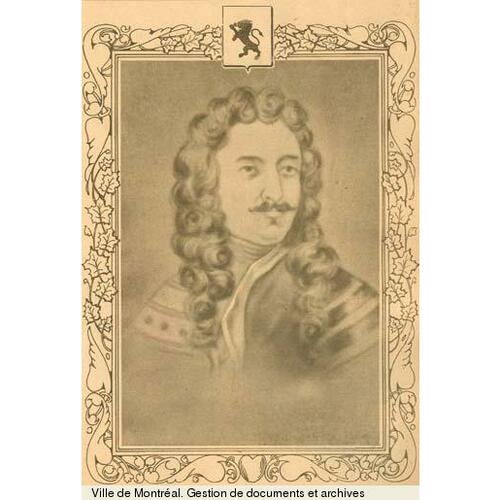
Source: Link
DUQUESNE (Du Quesne, Duqaine, Duquêne) DE MENNEVILLE, ANGE, Marquis DUQUESNE, naval officer and governor general of New France; b. c. 1700 at Toulon, France, third son of Abraham Duquesne and Ursule-Thérèse Possel; d. 17 Sept. 1778 at Antony (dept of Hauts-de-Seine), France.
From the beginning of the 17th century the Duquesnes were sailors, privateers, merchants, and soldiers. The family, which belonged to the Norman gentry, was Huguenot, but following the revocation of the edict of Nantes in 1685 Abraham Duquesne accepted conversion to Catholicism and remained in the royal navy. He became a rear-admiral and for several years held the post of commandant of the port of Toulon, the principal French naval base at that period. Following his example, four of his sons became sailors.
Ange Duquesne de Menneville joined the navy at a young age; by 1713 he was serving as a midshipman at Toulon. In 1726 he became a second ensign and three years later had his first contact with Canada while serving on the flute Éléphant under Louis-Philippe de Rigaud* de Vaudreuil. The ship, which was carrying the captain’s brothers, Pierre de Rigaud de Vaudreuil de Cavagnial and François-Pierre de Rigaud de Vaudreuil, ran aground near ile aux Grues in the St Lawrence. The circumstances surrounding the loss of the ship and the pillaging of the wreck by salvagers aided neither the commandant’s career nor Duquesne’s, which was delayed as a result. Duquesne was not rich enough to buy commissions. In 1735, when he received the certificate attesting to his Catholicity, he was promoted lieutenant-commander and then received command of his first ship, the Inconnu. He was made a knight of the order of Saint-Louis in 1738 and until 1744 served on the high seas.
The War of the Austrian Succession gave Duquesne the opportunity to demonstrate his abilities. He was stationed at Toulon, where he associated with figures who would become influential: La Galissonière [Barrin*], La Jonquière [Taffanel*], and Louis-Philippe de Rigaud de Vaudreuil, who belonged, as he did, to the fleet of Claude-Élisée de Court de La Bruyère. Duquesne distinguished himself in actions against the British and the African pirates. His drive was recognized, and in 1746 he received the rank of major and became port commandant of Toulon. Three years later he relinquished this post to go to sea again.
Seeking a successor to La Jonquière, the governor general of New France, in the autumn of 1751 the court selected Duquesne, whose name had been put forward by La Galissonière. By making this choice the court ensured continuity in its colonial policy, which was aimed particularly at protecting the fur trade and at French settlement of the Ohio valley. Duquesne received the title of marquis, a gratuity of 15,000 livres, and advances amounting to 27,000 livres. After several meetings with La Galissonière, he obtained his written instructions on 15 April 1752. The king asked him to devote special attention to ensuring the territorial integrity of the French empire in America. In particular he was to drive the British merchants out of the Ohio valley and establish peace with the Indian tribes that had been hostile since the uprising in 1747 [see Orontony*]. The minister of Marine, Rouillé, gave him a strict injunction to rely on Abbé Le Loutre in matters concerning Acadia. He indicated Oswego (Chouaguen) as a place to be taken if the British gave France reason for reprisals. Finally he asked him to help Intendant Bigot limit the expenses to which Canada was giving rise. These instructions – which were heavily influenced by La Galissonière – did not, however, set down any precise lines of conduct to be followed.
Marquis Duquesne landed at Quebec on 1 July 1752, to everyone’s surprise. Charles Le Moyne* de Longueuil had been serving as acting governor since La Jonquière’s death on 17 March 1752; it was not known that La Jonquière’s successor had already been provided for, and it was thought that the appointment of a new governor would be a long time in coming. Duquesne quickly attracted hostility in the colony. First he undertook to instil discipline in the troops and militia through reviews, inspections, and training for the numerous Canadians who had enrolled. Then, in October 1752 the Canadians learned that despite the officers’ protests Duquesne was going to launch a military expedition under Paul Marin* de La Malgue to occupy the Ohio valley.
Marin was to command a detachment of about 2,000 men, almost all of them whites in accordance with the orders of the court, which wanted France rather than its Indian allies to oppose the British merchants. During the winter of 1752–53 Duquesne devoted his attention to raising and equipping his army; with Bigot he regulated the sale of foodstuffs from Louisbourg, Île Royale (Cape Breton Island), and New England. His original plan was simple: Marin was to take the route followed by Pierre-Joseph Céloron* de Blainville in 1749 and to establish a series of forts. The expedition of 1753–54 would, however, encounter enormous difficulties and in the end was a partial failure, thus doing Duquesne serious harm. The minister of Marine blamed him for having lacked prudence and particularly for having chosen Marin, who was not the most senior officer in Canada. For his part Bigot denounced the means that Duquesne had utilized, considering it too costly for settling a small problem. In the summer of 1753 Bishop Pontbriand [Dubreil*] of Quebec had even asked that the expedition be abandoned. Duquesne succeeded, however, in convincing Rouillé that he had been unable to act otherwise under the circumstances, and he not only remained in charge in New France despite his critics, but also organized a new expedition.
Duquesne was aware that he had to take action early in the spring of 1754; George Washington, representing the governor of Virginia, had ordered Marin’s successor, Jacques Legardeur* de Saint-Pierre, to leave Fort de la Rivière au Bœuf (Waterford, Pa). Duquesne put Claude-Pierre Pécaudy de Contrecœur in charge of this new expedition; Pécaudy dislodged the small party of British from the forks of the Ohio and immediately undertook the construction of Fort Duquesne (Pittsburgh, Pa).
After Louis Coulon* de Villiers’s victory on 3 July 1754 at Fort Necessity (near Farmington, Pa) and Washington’s ensuing capitulation, Duquesne was able to proclaim his success. He was conscious, however, of the grave errors made in the Ohio valley: he expressed serious reservations about the clause in the capitulation that barred the Americans from the valley for only one year. Having transmitted to the minister his version of the affair and Washington’s journal and being satisfied with the way things had gone during his term of office, Duquesne asked in October 1754 for his recall.
During the winter of 1754–55 Duquesne learned that the British were preparing to retaliate; while assuring him they would do nothing of the sort, the minister of Marine, Machault, had advised him of Edward Braddock’s departure for America as commander of the armed forces. Consequently Duquesne took steps early in the spring to reinforce Fort Duquesne and the outlying posts. He again concentrated his forces to defend New France’s southwest frontier, even though he was aware of the British moves in the direction of Acadia and New York. In so doing he was complying with the instructions he had received to do nothing in Acadia and around Lake Champlain. Moreover, he knew that his successor would arrive with reinforcements for Canada and Louisbourg. He therefore entrusted the defence of the centre to the militia, moved his available forces to the west, and left the defence of the east to Louisbourg. These were ideal tactics for a man who underestimated the Americans’ military talents and who as well was about to be relieved of his post.
Indeed Pierre de Rigaud de Vaudreuil de Cavagnial landed at Quebec on 24 June 1755 during his absence; Duquesne, however, quickly returned from Montreal. The new governor general did not hesitate to criticize Duquesne’s actions: he presented a sombre picture of the colony, exhausted by the harsh Ohio campaign, and blamed him for having put all his efforts into that region, neglecting the other sectors where forts and posts were in poor shape just when the British were organizing a general offensive. All these criticisms were justified, but the responsibility did not lie with Duquesne alone, since in its desire for economy the court had rejected all his plans for repairing the defences. Vaudreuil and Duquesne did not cooperate and for a time were in open conflict. Duquesne sailed for France outraged by Vaudreuil’s attitude.
In France he explained his actions to the minister of Marine, who was satisfied, the more so since Braddock’s force in America had been cut to pieces. Only Fort Beauséjour (near Sackville, N.B.) had fallen [see Robert Monckton], but Duquesne laid that responsibility on Le Loutre. Duquesne was generously rewarded for his services in Canada, being forgiven the 27,000 livres advanced to him in 1752; he was consulted on Canadian matters, and seems to have met Montcalm* before the latter left for Canada.
Duquesne resumed his naval career. In April 1756 he was named inspector general of the coasts of France; on 23 June 1757 he assumed acting command of the fleet at Toulon and took part in minor actions until 1758. Defeated in an engagement with a British squadron commanded by Henry Osborn, Duquesne lost his vessel the Foudroyant and was captured and taken to England. The minister of Marine, Choiseul, treated him severely, but the king absolved him of blame and granted him a pension of 3,000 livres. This defeat did, however, raise questions about his future active career. Little is known of his subsequent endeavours, other than the fact that the king made him a commander of the order of Saint-Louis in 1763.
Duquesne’s retirement became final on 8 April 1776. Although as a result of the loss of the Foudroyant he was not appointed lieutenant-general of the Marine, in consideration of his 20 campaigns he was awarded continuation of his rear-admiral’s pay and the honorary title of lieutenant-general of the naval forces. On 4 Dec. 1776 Duquesne informed the court that in view of his age he no longer intended to visit the ports. He spent his last days in one or other of his residences in Paris and at Antony. As he had no offspring when he died in September 1778, he left his fortune, estimated at 200,000 livres, to his nephews and nieces, and his servants.
Duquesne had had an active career, serving and fighting energetically. During his stay in New France this overbearing, proud, but obedient man was unpopular. It was said that Bigot himself feared him. Putting his “special” mission ahead of all else, he carried out his task resolutely, intransigently, and unhesitatingly. Warned in advance that many would disapprove of the military occupation of the Ohio valley because the economy of the colony could not stand such a drain on its manpower and resources, he was mistrustful of the colonials, and they did not appreciate him. Only the recommendations from Rouillé and Machault for clemency and prudence softened his behaviour towards dirty soldiers, undisciplined militiamen, insolent officers, and merchants without strong ties to the mother country.
AN, Col., B, 95–97, 99; C11A, 99, 100. Bégon, “Correspondance” (Bonnault), ANQ Rapport, 1934–35, 271. Coll. des manuscrits de Lévis (Casgrain), VII. Doreil, “Lettres” (A. Roy), ANQ Rapport, 1944–45. Papiers Contrecœur (Grenier), 15, 96–98, 117–19, 223–24. W. L. Clowes, The Royal Navy; a history from the earliest times to the present (7v., London, 1897–1903), III, 189–90. C. W. Dahlinger, The Marquis Duquesne, Sieur de Menneville, founder of the city of Pittsburgh (Pittsburgh, Pa., 1932). Frégault, François Bigot, II. Régis Roy, “Le gouverneur Du Quesne,” BRH, XII (1906), 53.
Cite This Article
Pierre-L. Côté, “DUQUESNE (Du Quesne, Duqaine, Duquêne) DE MENNEVILLE, ANGE, Marquis DUQUESNE,” in Dictionary of Canadian Biography, vol. 4, University of Toronto/Université Laval, 2003–, accessed June 23, 2025, https://www.biographi.ca/en/bio/duquesne_de_menneville_ange_4E.html.
The citation above shows the format for footnotes and endnotes according to the Chicago manual of style (16th edition). Information to be used in other citation formats:
| Permalink: | https://www.biographi.ca/en/bio/duquesne_de_menneville_ange_4E.html |
| Author of Article: | Pierre-L. Côté |
| Title of Article: | DUQUESNE (Du Quesne, Duqaine, Duquêne) DE MENNEVILLE, ANGE, Marquis DUQUESNE |
| Publication Name: | Dictionary of Canadian Biography, vol. 4 |
| Publisher: | University of Toronto/Université Laval |
| Year of revision: | 1979 |
| Access Date: | June 23, 2025 |




